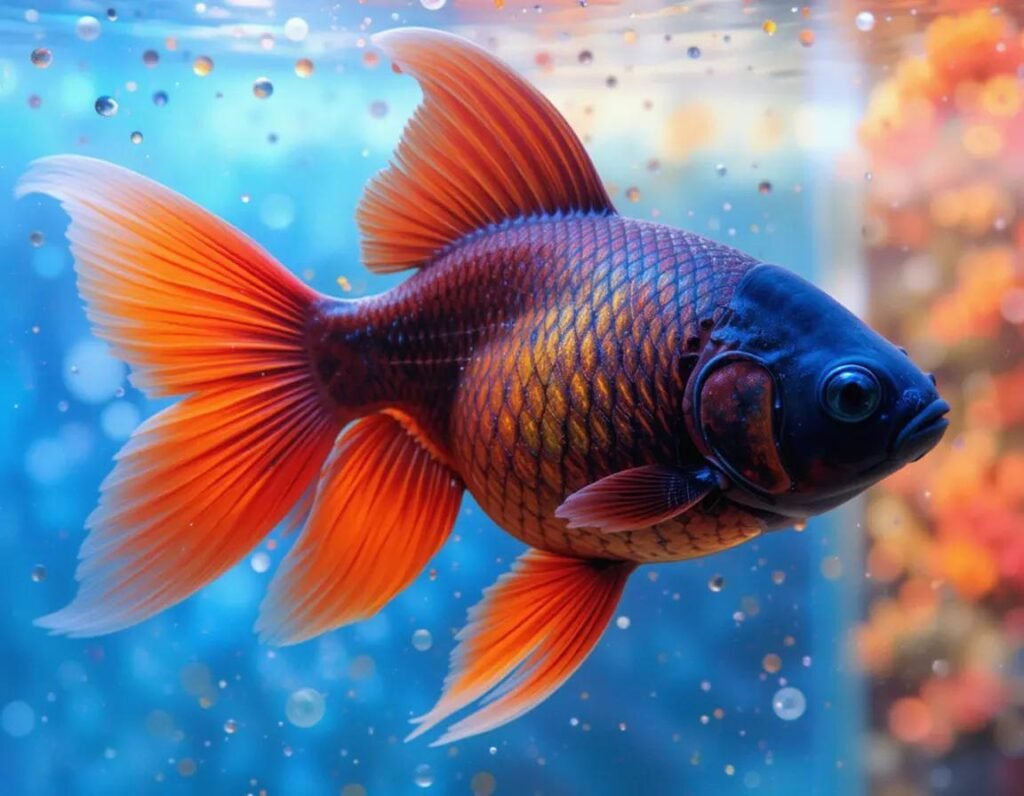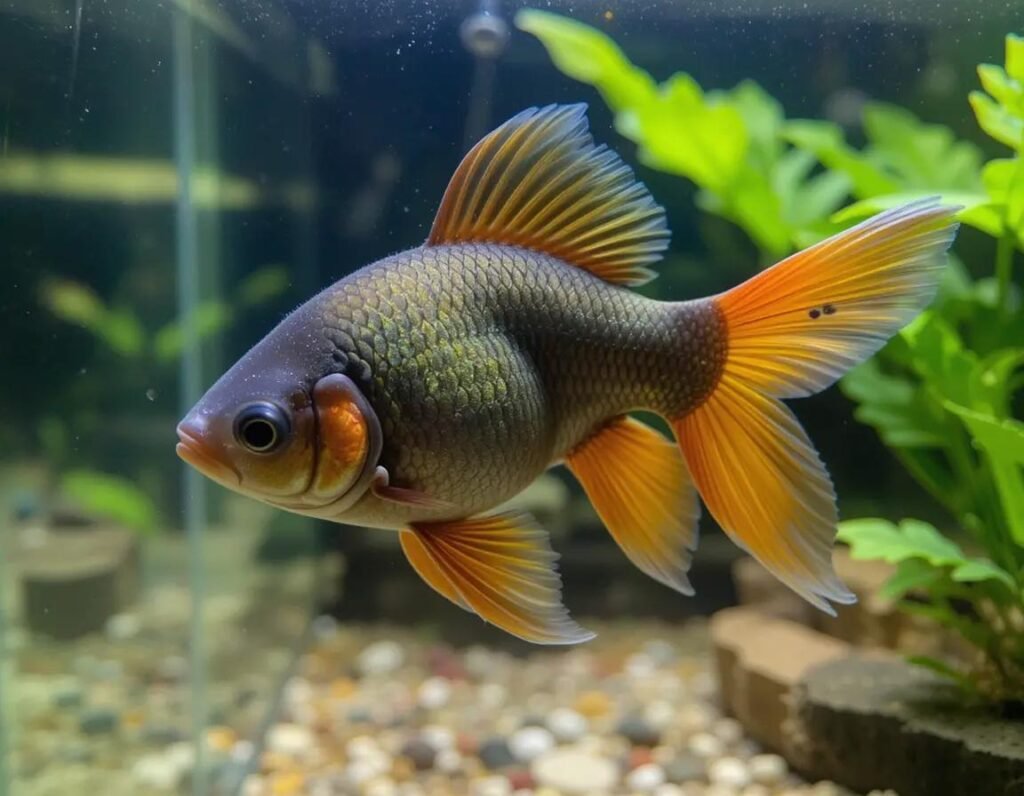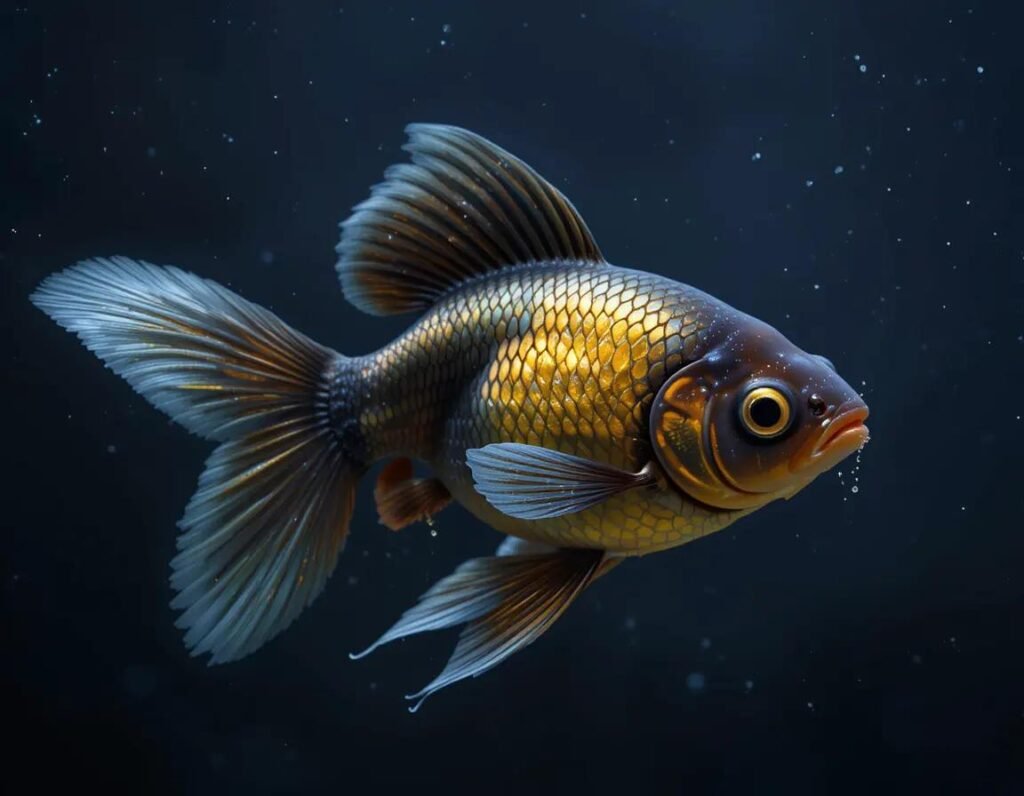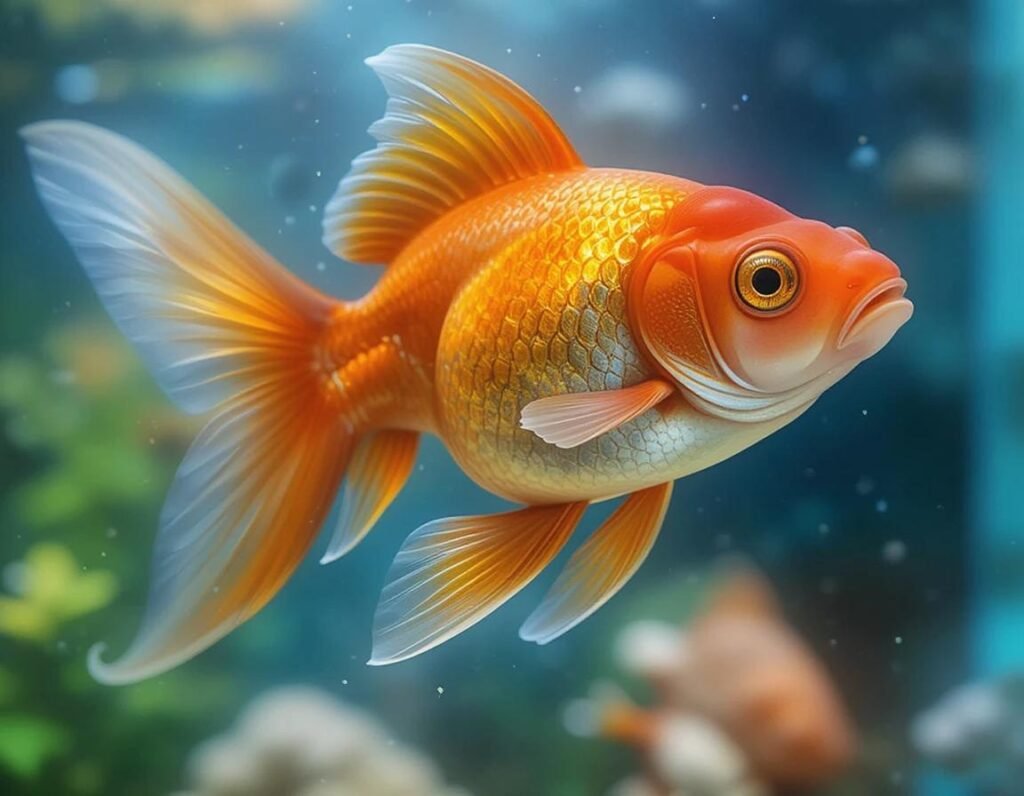
If you’ve ever glanced at your goldfish and noticed it’s starting to turn a little bit darker—like it’s trying out a new gothic look—don’t panic. While it may seem a little alarming, there are a few possible reasons why your goldfish is deciding to embrace its inner “mysterious” side. Whether it’s a sudden change in color or a gradual shift, we’re here to break down the mystery and help you understand why your finned friend might be turning black.
1. Natural Color Change (Goldfish Are Like Chameleons)
Goldfish are famous for their golden, orange, and sometimes even red hues, but did you know they’re like little aquatic chameleons? In fact, goldfish can change colors naturally over time. This can happen due to various factors, including age, genetics, and the environment.
The Aging Process:
As goldfish mature, especially older fish, their color can fade or change entirely. A goldfish that was once bright orange may eventually turn white or even black as it gets older. So, if your goldfish is experiencing a “mid-life crisis,” it could simply be getting some gray hairs—or in this case, black patches. It’s the fish equivalent of embracing your inner wisdom, right?
2. Stress or Environmental Changes
Goldfish are sensitive little creatures. Change anything in their environment—like water temperature, water quality, or even tankmates—and your goldfish might respond by changing color. Stress-induced blackening is pretty common, and it’s your fish’s way of saying, “Hey, something’s not right here!”
- Water Quality Issues: Poor water quality, like high ammonia levels, can cause goldfish to become stressed, which can result in black spots or a darker overall color. So, before you call in the fish psychiatrist, check your water parameters (ammonia, nitrites, pH) to ensure everything is in tip-top shape.
- Sudden Temperature Changes: A sudden drop in water temperature could make your fish feel chilly, and it might respond by turning black as a sign of stress. Fish don’t like extreme changes, so keep the water temperature stable, especially in colder months.
- Overcrowded Tank: When there are too many fish in a tank, things can get crowded, and that can be stressful for your goldfish. It may express its discomfort with black spots or an overall color change. More space for your little swimmer is always a good idea!
3. Healing from Injury
Goldfish are no strangers to a little roughhousing—especially if they share a tank with other finned companions. Sometimes, goldfish may develop black patches as they heal from injuries, such as nipped fins or scratches. These black areas are usually just a sign of the healing process and will often fade as the fish recovers. Just like how a bruise on a human turns colors as it heals, a goldfish’s injury site may turn black before returning to its usual color.
4. A Fungus or Parasite Problem
Unfortunately, black spots can sometimes be caused by a fungus or parasite infection. If the dark areas are accompanied by swelling, lesions, or abnormal behavior (like rubbing against objects in the tank), then it’s time to investigate a bit further. Black spot disease is one common condition caused by a parasitic infestation, although it doesn’t typically harm the fish significantly.
If you suspect a fungal or parasitic infection, it’s best to treat your fish with appropriate medications or isolate it in a quarantine tank until the issue clears up. But don’t worry—most of the time, these infections can be treated with some care and attention.
5. Genetic Factors (Goldfish Going Through Their Goth Phase)
Some goldfish breeds are just more likely to change color than others. For example, black moors, ranchus, and other fancy varieties are prone to developing black markings naturally. So, if your goldfish is a breed that has a tendency for color shifts, this may just be part of its genetics. It’s like your fish is just going through a phase, where it’s trying on a darker persona.

6. Too Much Light Exposure (Sunburn, Fish-Style)
Okay, we’re not saying your goldfish is going to the tanning salon, but just like people, fish can sometimes be a little too exposed to light. If your goldfish is getting too much direct sunlight, it may develop dark patches on its scales, kind of like a fishy sunburn.
Make sure your tank isn’t in direct sunlight all day long, and if you’re using artificial lighting, adjust it so it’s not too intense. Goldfish like moderate lighting, so they can show off their beautiful golden tones without going overboard.
7. Is My Goldfish’s Black Color Permanent?
In most cases, your goldfish’s black coloration isn’t permanent. If the change is due to a natural aging process or genetic factors, your fish might sport a new shade for a while, but it may eventually revert to its original color or maintain a subtle mix of colors. However, if the change is due to stress or illness, once the cause is addressed (like improving water quality or treating a fungal infection), your goldfish could go back to looking like its former bright self.
So, if you’re hoping your goldfish doesn’t turn into a permanent “emo” fish, there’s a good chance that the black spots or color changes are just temporary and can be fixed with a little TLC.
8. When Should I Be Concerned About My Goldfish Turning Black?
While black spots or a darkened body can be totally normal, there are some signs you should keep an eye on to make sure everything is okay with your aquatic buddy:
- Loss of Appetite: If your goldfish refuses to eat or shows no interest in food, it could be a sign of stress, illness, or an underlying health issue.
- Lethargy: If your goldfish becomes unusually sluggish or hides in the corner of the tank more often than usual, it’s time to investigate further.
- Scratching or Rubbing Against Objects: This behavior could suggest a parasitic or fungal infection. If your goldfish is rubbing against decorations or the tank surface, it’s time for a closer look.
- Swelling or Odd Growths: If the black spots are accompanied by swelling, lumps, or unusual growths, it’s best to consult a vet. This might be a more serious issue, like a tumor or severe infection.
9. What Should I Do If I Think My Goldfish Has Black Spot Disease?
If you notice your goldfish turning black due to black spot disease, caused by a parasitic infestation, don’t worry too much—it’s typically treatable. Here’s what to do:
- Quarantine Your Goldfish: If you think your fish has an infection, consider placing it in a separate quarantine tank to keep it away from the other fish.
- Treat with Medication: There are anti-parasitic treatments available at pet stores and online that are safe for goldfish. Follow the directions on the packaging.
- Improve Tank Conditions: Test the water, clean the tank, and ensure the water parameters (like ammonia, nitrites, and pH levels) are within the ideal range. Stress can make the problem worse.
10. Can I Prevent My Goldfish From Turning Black?
While you can’t completely control how your goldfish’s color will change over time, there are a few steps you can take to ensure your fish stays healthy and stress-free:
- Maintain Water Quality: Regular water changes, proper filtration, and testing the water for ammonia, nitrites, and pH can help keep your goldfish in tip-top shape.
- Avoid Stress: Don’t overcrowd the tank, and avoid sudden temperature or lighting changes. The more stable the environment, the less likely your goldfish will turn black due to stress.
- Watch for Illnesses: Keep an eye out for symptoms of illness and address any health issues quickly. A happy, healthy goldfish is less likely to turn black due to infection or disease.
11. How Long Will My Goldfish Stay Black?
The length of time your goldfish remains black depends on the cause of the color change. If it’s due to natural aging or genetics, your goldfish might stay that way for the rest of its life. But if the change is caused by stress, injury, or infection, you may notice that your goldfish’s color gradually returns to its original hue once the cause has been addressed.
For instance, if the black color is a result of healing from an injury, you’ll likely see the color fade over time as the healing process completes. On the other hand, if your goldfish is simply going through a “fashionable” phase (thanks to genetics), it could keep that new black look indefinitely.
12. Can Goldfish Turn Black from Poor Diet?
While diet doesn’t directly cause goldfish to turn black, poor nutrition can lead to health problems that could contribute to color changes or stress. Goldfish that aren’t getting a balanced diet may experience weakened immune systems, which in turn could make them more susceptible to infections or illnesses that could result in black spots or discoloration.
Feeding your goldfish a varied diet of high-quality fish flakes, pellets, and occasional treats like vegetables will help keep them healthy and vibrant, preventing any issues that could lead to unwanted color changes.

13. Are There Specific Goldfish Varieties Prone to Turning Black?
Yes! Some types of goldfish are more likely to develop black spots or turn darker than others. If you own a black moor, ranchu, or veiltail goldfish, you may notice that their colors can change, sometimes even drastically, over time. These fish are known to have color shifts as part of their natural genetic makeup.
Black Moors: This variety often starts out gold or orange but is more likely to turn completely black as they age. It’s basically their signature look!
Ranchu: These little guys can sometimes develop black markings, especially when they’re stressed or as they grow older.
While these changes are completely normal, it’s always good to keep an eye out for anything that might seem off—just in case your fish’s “dark side” is due to stress or illness.
14. Should I Be Worried About Black Color in Goldfish?
Most of the time, no, you shouldn’t. As long as your goldfish is otherwise healthy—swimming around, eating well, and looking active—a bit of black color probably isn’t a cause for concern.
However, if the black coloration comes with other symptoms like swollen fins, lack of appetite, or if your goldfish is behaving strangely (like constantly hiding), it’s time to investigate further. In those cases, it could be a sign of illness, stress, or infection, and it’s best to address the issue right away.
Final Thoughts: Let Your Goldfish Shine (or Turn Black, or Whatever)
At the end of the day, your goldfish is probably just expressing its individuality with its new look. Whether it’s turning black due to natural color changes, a little bit of stress, or just going through a temporary phase, don’t let it stress you out too much. In fact, embrace the unique vibe your goldfish is throwing out—maybe it’s a sign of an artistically inclined fish!
After all, it’s not every day you get a fish that can change colors like a mini aquatic chameleon. So sit back, relax, and enjoy your goldfish—whether it’s turning gold, black, or somewhere in between. They’re still the same lovable little swimmer you’ve always known, and their color is just one more quirk that makes them special.
Conclusion: Embrace the Black!
So, the next time you see your goldfish trying out a “mysterious” new look, remember: it’s usually nothing to worry about. Whether it’s due to aging, stress, an injury, or just a natural color change, your goldfish is probably still the same lovable fish beneath the darker hue. As long as they’re swimming happily and showing no signs of severe illness, that black color is just another part of their charm.
And hey, if your goldfish has decided to join the ranks of the cool fish with black spots, just consider it a new trend in the aquatic world—who says fish can’t be fashionable?


